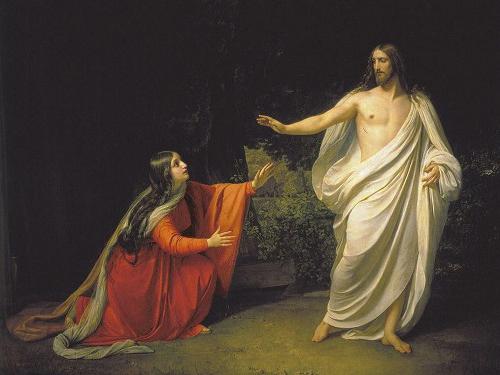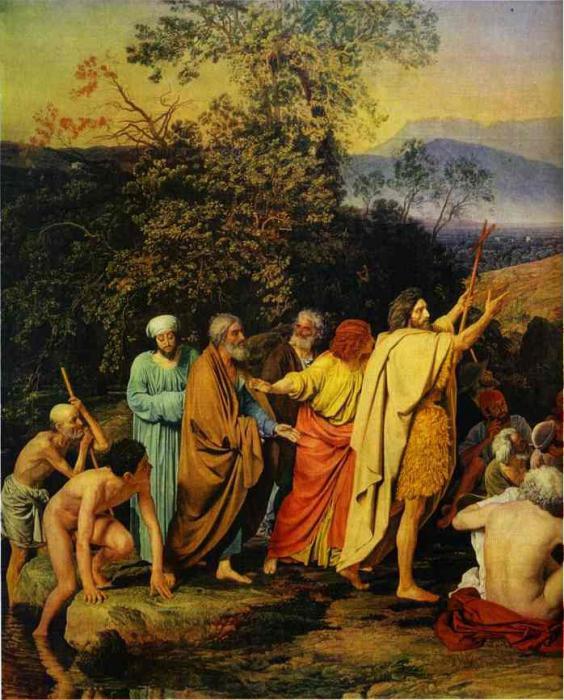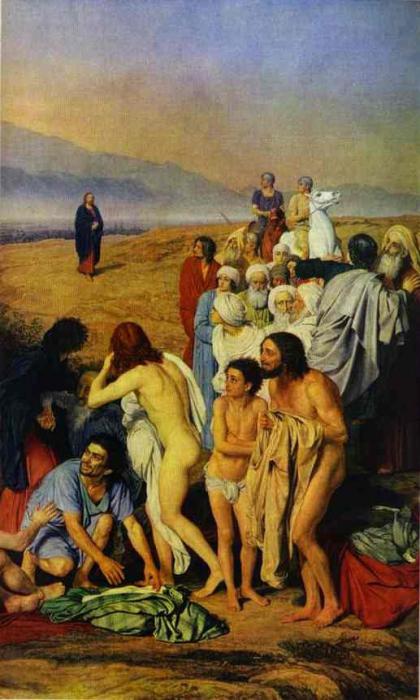In a separate room of the Tretyakov Gallery you can see the picture of A. Ivanov "The Appearance of Christ to the People." The canvas amazes with its size and color of paints, the complexity of the composition. It is known about the author himself that during his life he did not receive the coveted recognition from his compatriots. And this despite the fact that he spent over 20 years working on his work, most of which he spent in a foreign land. But now everyone can look at the picture “The Appearance of Christ to the People” in detail. Its description is given in this article.
Brief biography of the artist
What is known about the life of the author of the canvas? He was born in 1806 in the family of the artist. Studied the future master at the Imperial Academy of Arts. For success in drawing as a teenager, he received two silver medals. Then two gold awards followed. After that, the Society for the Encouragement of Artists decided to send Alexander to Italy for excellence in painting. It was in this country that the artist created his grandiose canvas “The Appearance of Christ to the People”. In Rome, the picture was a huge success. But at home she was met at first coolly. Only progressive youth, arguing at the canvas, recognized in him the greatest example of a completely new turn in painting. A little after the exhibition, the artist Ivanov fell ill with cholera and died. After that, Tsar Alexander II bought the painting “The Appearance of Christ to the People” for 15,000 rubles. The history of the painting is such that soon the masterpiece migrated to Moscow, where it ended up in the Tretyakov Gallery. There he is to this day.
Theme of the picture
For a long time, the artist was fascinated by the idea of creating a canvas depicting the appearance of the Messiah. Rereading the Gospel, he came to the creation of a picture with a biblical plot. Before him, this theme was used in painting by Domenico di Tommaso del Ghirlandaio, an Italian Renaissance artist, when creating his masterpiece “Baptism by St. John Christ”. Let us turn to the part of the Bible containing the narrative of an important event, to which Ivanov devoted his painting. The appearance of Christ to the people is one of the most important episodes of the New Testament.
In the mountains of Hermon and Lebanon, the sacred river Jordan originates. In its lower reaches are those sacred places where John the Baptist preached. His parents, Elizabeth and Zachariah, were already at an advanced age when they had a son. The boy was called John. Many hardships fell to the future prophet. When the king of Judea, Herod ordered to kill all the babies in the city of Bethlehem, his mother, Elizabeth, fled with her two-year-old son to the desert to save her child from bloody reprisal. Soon John lost his parents. He lived alone in the desert, fed on plants and dressed in animal skins. When the boy was 13 years old, he went to the Jordan River to inform the locals about the imminent coming of the Messiah. People from nearby villages began to flock to him. They listened to his every word. John called them to repent of their sins. And those who did this, the prophet immersed in the "jets of Jordan" to christen. So the great river became the baptismal font of the whole world. John the Baptist spoke of the imminent coming of the Savior. Everyone was waiting for this.
Finally, the welcome day has come. On the banks of the Sacred River, Jesus Christ appeared in the simple robes of a Galilean carpenter. None of those present, except the Forerunner, noticed this. The Son of God walked humbly, not distinguishing himself from other people. He entered the waters of the Jordan to be baptized by John. Bathing in holy water for him later will end with a bloody bath at Calvary. It was this story about the baptism of suffering people, waiting for the coming of the Messiah, that Ivanov depicted on his canvas.
How did the work on the canvas go?

The master’s work on the painting “The Appearance of Christ to the People” lasted over 20 years. The history of its creation is very interesting. Three years before this, the artist wrote the painting “The Appearance of the Risen Christ to Mary Magdalene”. Before starting work on a masterpiece, the author performed more than 600 sketches. Ivanov persistently searched for the prototypes of the heroes of the picture among friends, random passers-by on the streets, markets, and so on. Each figure, according to the master, was supposed to represent a whole world with a difficult life fate. Working on the picture, Ivanov several times changes the original conceived composition. Here he denied the conventions of academic painting. In a manner peculiar only to him, the artist realistically depicted the faces of people, conveying their emotions. He also achieved great success in transferring space and volume. The master spent most of the time working on the masterpiece in Italy. Interestingly, the picture was never completed. This was prevented by the painter's progressive eye disease, as well as a change in his worldview. At the end of his work on the canvas, Ivanov disbelieved that religious preaching, which brings truth through art, can help transform a person. But even in this unfinished form, the canvas is an outstanding example of classical monumentalism.
Landscape
The canvas is very colorful. Nature on it is no less expressive than the figures of people. As you know, the action depicted on the canvas takes place in Palestine. But the artist did not have the opportunity to visit this side for a detailed study of the nature of those places. He looked for the appropriate nature for a long time in Italy. And he managed to find her. For months he lived among the marshes and in the outbacks in this country, trying to recreate the nature of the Holy Land in his work. With amazing accuracy, expressiveness and realism, the master portrays it. Here is a rocky plain scorched by the sun, and mountains in a blue haze in the distance, and the bank of the Sacred River, covered with trees and shrubs. It is amazing what amazing color combinations Ivanov found here. “The Appearance of Christ to the People” is a picture that is truly a masterpiece. It seems that the master painted with a brush, on the tip of which was sunlight. So everything in her is light, radiant, exultant.
Description of the picture

In the foreground of the canvas is a group of Jews who came to the waters of the Sacred River to listen to John’s preacher, to be cleansed of sins and receive baptism from him. Here are people of different ages, estates and beliefs. How strong the differences between the Jews depicted in the picture are, the emotions on their faces are so different. Someone looks at John with emotion and excitement before the coming of the Messiah, someone with a skeptical smile and distrust, and someone even with anger and hatred. In the painting “The Appearance of Christ to the People,” the artist depicted next to a well-to-do elderly man and his slave with a rope around his neck, squatting down near his master and giving him clothes. It is expressive that with what attention and tenderness the slave listens to the prophet. Looking at him, you can be sure that this slave will become one of the most ardent supporters of Christianity. The words of the Baptist make such a strong impression on him. It was the new faith, according to the master, that was supposed to unite people of different classes.

Next to the prophet are the apostles: a effeminate red-haired young man in a red cloak and yellow tunic John the Theologian and a gray-bearded old man in a dark olive cloak with a thoughtful face Andrei. These are future disciples and followers of Christ, who after the resurrection of the Savior will tell people about the earthly life of the Messiah. There are so-called “doubters” in the crowd of listeners of the Forerunner. This is a young man with a handsome face framed by a black beard. He wraps himself chillly in a long blue-green tunic. His eyes are down. Facial expression speaks of distrust and doubts about the prophet's rightness. The second “doubter” is a gray-bearded elderly man in a dark cloak. He carefully listens to the words of John. Probably, these are pagans who came to listen to a sermon on the coming of the Savior and who did not believe in miracles. To their left are an old man leaning on a stick and a naked young man. They have just bathed in the waters of the Jordan River and are now looking at John curiously.
To the right of the prophet is a group of people whose eyes are fixed on Christ walking in the distance. Among them stand out scribes hostile to the preacher and high priests. They are supporters of the old faith. On their faces one can read the hostility of the new doctrine, and the cold indifference to what is happening, and distrust, and even outright anger. This is especially clearly seen in the expression on the face of an old man with an unpleasant thick nose. He is depicted in profile. The following figures of the first plan are also expressive. This is a half-naked young man with loose red curls. His body and gaze are turned to Christ. Next to him are the so-called "trembling" - a boy and father. They have just bathed in the waters of the Sacred River, having been baptized. With trepidation and tenderness they listen to the words of John. Their whole image symbolizes their readiness to accept a new religion and to believe in the coming of the Messiah. Further in the crowd are Roman legionnaires sent here to observe order, women, a repentant sinner in a maroon cloak. Interestingly, a good friend of Ivanov, Nikolai Gogol, acted as a model for the image of this lawless person. The painting “The Appearance of Christ to the People” clearly shows the similarities between the faces of the great writer and hero. This is especially noticeable on sketches for the canvas.
The figure of John the Baptist

According to the Bible, the prophet spent a lot of time in the desert, dressing in animal skins, eating plants and preparing himself for a righteous life away from people. So in the painting “The Appearance of Christ to the People, whose Style Can Be Defined as Academic Realism, John the Baptist is depicted as a tall strong man with long hair randomly falling from his shoulders and a beard. He has a pale, thin face, sunken eyes, betraying a man in him, who spent many days alone and rejoiced for the fate of mankind. He is dressed in camel skin and a light-colored cloak of rough material. Strong arms and legs, a high clever forehead, a firm, determined look speak of the inner strength of the Forerunner. He points people to the figure of a man who has just appeared on a rocky plain, scorched by the sun. This is Jesus Christ himself - the Messiah, whom the followers of the prophet have been waiting for so long. In the left hand of the Forerunner is a cross - a symbol of a new faith. John's decisive gesture, his expression on his face speaks of the excitement and enthusiasm with which he meets the long-awaited Messiah.

Figure of christ
The central figure of this composition is John the Baptist. But the Savior is depicted in the distance. But at the same time, the artist does not detract from his significance in the composition as a whole. In the painting “The Appearance of Christ to the People,” the author presents the Messiah as a person in simple robes. But everything in him betrays the “son of God”: both the majesty of the steps, and the mystery of the outlines of his figure, contrasting with the outlines of the mountains ... It is difficult for the viewer to see the face of the Savior. What emotions does it express? It seems that it has everything: calm, and grandeur, and joy, and tenderness ... The silhouette of Christ is expressive and at the same time blurred and unclear. It carries mystery and inexplicability. This is a special idea of the author of the picture. He portrayed the Messiah in this way for two reasons. First, he wanted to focus not on the face and figure of the Savior, who came to this world to save mankind from sins, but on the reaction of people to the appearance of Jesus. And secondly, Christianity itself at that time seemed to the Jews as mysterious and sublimely incomprehensible.
Analysis of the painting “The Appearance of Christ to the People”
The general public did not immediately understand the author’s intention, the deep philosophical meaning inherent in the work. Therefore, the work of the artist was accepted at first very cool. The public is accustomed to seeing heroism in any genre of art, in whatever form it appears. And here the master portrayed real people with their real emotions. For the public it was nonsense! In painting, people have not yet seen. How many different feelings and emotions a person preparing for an important event in his life can have is what Ivanov wanted to show in his work. “The Appearance of Christ to the People” is a picture-crown of his work. The great merit of the artist here is his subtle understanding of human psychology. In each hero of his composition - a whole world of emotions, feelings, emotions. Looking at any character of the canvas, one can easily imagine not only what this person lives, what class and religion he is, but also what is his inner world that drives him. At the beginning of the work on the painting, the master carried away the biblical plot. But at the end of it, he managed to become disillusioned with the possibilities of religion for the transformation, degeneration of man. Further, he wanted to write in the same vein, but no longer referring to the gospel, but depicting the thoughts and feelings of the people of his time in his homeland. It is a pity that he failed to do this. He was struck by a serious illness. But the hostility and hostility with which the public initially accepted his work also played a significant role in this.
Fate painting
In 1857, work on a huge canvas was completed. The dimensions of the painting are astounding: 540 x 750 cm. In 1858, Ivanov decided to go to St. Petersburg in order to present the masterpiece to the general public. The funds for the transportation of a large-scale work of art were donated by the
Grand Duchess Elena Pavlovna. An exhibition of the canvas “The Appearance of Christ to the People” and all sketches and sketches for it was held in the hall of the Academy of Arts. A work of art has not received an unambiguous assessment. Officials greeted him rather coolly. But the public made a strong impression on the picture. Progressive people of that time unanimously recognized in the author the canvases of a brilliant artist who discovered a new technique in painting. Six weeks after the exhibition, Ivanov fell ill with cholera and died. Just a few hours after that, Emperor Alexander II bought the painting for 15,000 rubles - a considerable amount at that time. He brought it as a gift to the Rumyantsev Museum of St. Petersburg. A separate pavilion was built for such a large canvas. In 1925, the Rumyantsev Museum, which had already moved to Moscow, was disbanded. This work of art was transferred to the State Tretyakov Gallery. In 1932, a separate hall was built here in Lavrushinsky Lane for such a large-scale canvas. Here it is to this day. In the city of St. Petersburg, the State Russian Museum contains numerous sketches and three sketches for the painting.
Interesting Facts
- This picture is the author’s report on state pension in Italy. The artist was sent to this country for 4 years to improve in art. For as many as 20 years, Alexander Ivanov managed to stretch the “internship”. “The Appearance of Christ to the People” is a picture on which he worked.
- One of the figures was painted by a master from Nikolai Gogol. This is one of the swimmers located closer to Christ. On a large canvas, the similarity is little noticeable. But on the sketches for the picture, it is clearly traceable.
- The old man on the left stands in a white loincloth. In reflection, this piece of clothing appears red.
- Near John the Baptist, a slave in a blue cape is depicted. His face is green. This is clearly seen in the sketches for the picture.
- Among the figures of the central group of the composition, a wanderer with a staff in a wide-brimmed gray hat stands out clearly. In this image, the artist captured himself.
- Just a few weeks after the public presented the picture “The Appearance of Christ to the People,” Alexander Ivanov died. The last days of his life were full of humiliation and despair. It is known that he did not receive the promised fee for work. Art connoisseurs criticized her. After the death of the author, the king graciously granted him the Order of St. Vladimir and bought the painting for considerable money at that time.